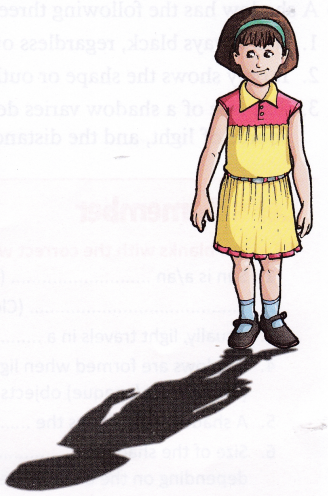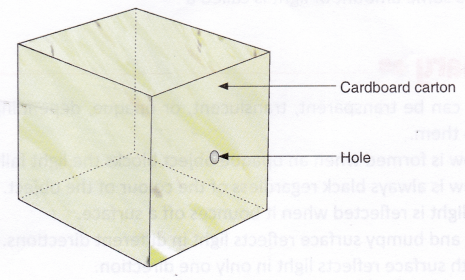How Shadows Are Formed
An opaque object blocks the light falling on it. This creates an area of darkness on the side of the object away from the source of light. A translucent object also creates a faint area of darkness. An area of darkness formed by an opaque object obstructing light is called a shadow. The following three things are required for a shadow to form:
- a source of light
- an opaque object
- a screen or surface behind the object.

A shadow will not form if any of these is absent. This explains why we cannot see a shadow in the dark. It is only when light rays are obstructed by an opaque object that we get a shadow of the object.
Let us perform an activity to learn about the characteristics of a shadow.
Activity
Aim: To obtain a shadow and study its characteristics
Materials needed: A torch, a few small opaque objects of different shapes and sizes and a white screen (a piece of cardboard covered with white paper).
Method:
- Turn on the torch and place the object (whose shadow you want to study) in front of it.
- Hold the screen on the other side of the object to get the shadow.
- Ask your friend to trace out the outline of the shadow on the screen.
- Now, keeping the positions of the torch and the screen to the torch. What do you see?
- Note the colour and the size of the shadow.
- Repeat steps 1 to 5 for different objects.

Observation: The shadow becomes bigger when the object is moved closer to the torch and smaller when it is moved closer to the screen. The colour of the shadow is always black.
Characteristics of a Shadow
A shadow has the following three characteristics:
- It is always black, regardless of the colour of the object used to make the shadow
- It only shows the shape or outline of the object and not the details.
- The size of a shadow varies depending on the distance between the object and the source of light, and the distance between the object and the screen.
A very interesting phenomenon occurs when an object forms an image by reflection. This is something all of us must have noticed while seeing ourselves in the mirror. When we lift our right hand, the image in the mirror appears to lift its left hand. This seeming left-right reversal is called lateral inversion.
An image is different from a shadow. Some of the differences between an image and a shadow are given in Table.
| Image | Shadow |
| 1. Has the colour of the object. | 1. Is always black, regardless of the colour of the object. |
| 2. Gives the details as well as the outline of the object. | 2. Gives only the outline of the object. |
| 3. Undergoes lateral inversion (i.e., left-right reversal). | 3. Does not undergo lateral inversion. |
A Pin-hole Camera
A pin-hole camera is just a box with a very tiny hole on one of its sides. Light falls on the hole, and an inverted image is formed on the side opposite to the hole. The human eye acts very much like a pin-hole camera.

Activity
Aim: To observe differences between the image and the shadow of the same object.
Material needed: A mirror.

Method: Go out during the day and study your shadow. Compare it with your image as you see it in a mirror. Write down the similarities and differences.